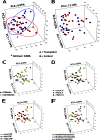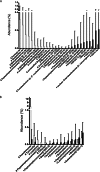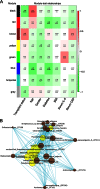Transplantation-associated long-term immunosuppression promotes oral colonization by potentially opportunistic pathogens without impacting other members of the salivary bacteriome
- PMID: 23616410
- PMCID: PMC3675961
- DOI: 10.1128/CVI.00734-12
Transplantation-associated long-term immunosuppression promotes oral colonization by potentially opportunistic pathogens without impacting other members of the salivary bacteriome
Abstract
Solid-organ transplant recipients rely on pharmacological immunosuppression to prevent allograft rejection. The effect of such chronic immunosuppression on the microflora at mucosal surfaces is not known. We evaluated the salivary bacterial microbiome of 20 transplant recipients and 19 nonimmunosuppressed controls via 454 pyrosequencing of 16S rRNA gene amplicons. Alpha-diversity and global community structure did not differ between transplant and control subjects. However, principal coordinate analysis showed differences in community membership. Taxa more prevalent in transplant subjects included operational taxonomic units (OTUs) of potentially opportunistic Gammaproteobacteria such as Klebsiella pneumoniae, Pseudomonas fluorescens, Acinetobacter species, Vibrio species, Enterobacteriaceae species, and the genera Acinetobacter and Klebsiella. Transplant subjects also had increased proportions of Pseudomonas aeruginosa, Acinetobacter species, Enterobacteriaceae species, and Enterococcus faecalis, among other OTUs, while genera with increased proportions included Klebsiella, Acinetobacter, Staphylococcus, and Enterococcus. Furthermore, in transplant subjects, the dose of the immunosuppressant prednisone positively correlated with bacterial richness, while prednisone and mycophenolate mofetil doses positively correlated with the prevalence and proportions of transplant-associated taxa. Correlation network analysis of OTU relative abundance revealed a cluster containing potentially opportunistic pathogens as transplant associated. This cluster positively correlated with serum levels of C-reactive protein, suggesting a link between the resident flora at mucosal compartments and systemic inflammation. Network connectivity analysis revealed opportunistic pathogens as highly connected to each other and to common oral commensals, pointing to bacterial interactions that may influence colonization. This work demonstrates that immunosuppression aimed at limiting T-cell-mediated responses creates a more permissive oral environment for potentially opportunistic pathogens without affecting other members of the salivary bacteriome.
Figures




Similar articles
-
Exploring salivary microbiota in AIDS patients with different periodontal statuses using 454 GS-FLX Titanium pyrosequencing.Front Cell Infect Microbiol. 2015 Jul 2;5:55. doi: 10.3389/fcimb.2015.00055. eCollection 2015. Front Cell Infect Microbiol. 2015. PMID: 26191508 Free PMC article.
-
Preliminary characterization of the oral microbiota of Chinese adults with and without gingivitis.BMC Oral Health. 2011 Dec 12;11:33. doi: 10.1186/1472-6831-11-33. BMC Oral Health. 2011. PMID: 22152152 Free PMC article.
-
Oral Microbiome in HIV-Infected Women: Shifts in the Abundance of Pathogenic and Beneficial Bacteria Are Associated with Aging, HIV Load, CD4 Count, and Antiretroviral Therapy.AIDS Res Hum Retroviruses. 2019 Mar;35(3):276-286. doi: 10.1089/AID.2017.0200. Epub 2018 Jul 23. AIDS Res Hum Retroviruses. 2019. PMID: 29808701 Free PMC article.
-
Calcineurin inhibitor-free immunosuppression in pediatric renal transplantation: a viable option?Paediatr Drugs. 2011 Feb 1;13(1):49-69. doi: 10.2165/11538530-000000000-00000. Paediatr Drugs. 2011. PMID: 21162600 Review.
-
Bacterial pneumonia in kidney transplant recipients.Respir Med. 2018 Apr;137:89-94. doi: 10.1016/j.rmed.2018.02.022. Epub 2018 Mar 6. Respir Med. 2018. PMID: 29605219 Review.
Cited by
-
Immunosuppressive Agents and Infectious Risk in Transplantation: Managing the "Net State of Immunosuppression".Clin Infect Dis. 2021 Oct 5;73(7):e1302-e1317. doi: 10.1093/cid/ciaa1189. Clin Infect Dis. 2021. PMID: 32803228 Free PMC article. Review.
-
Harnessing the microbiome to improve clinical outcomes for cancer, transplant, and immunocompromised patients in the intensive care unit (ICU).Front Cell Infect Microbiol. 2025 Jun 12;15:1577108. doi: 10.3389/fcimb.2025.1577108. eCollection 2025. Front Cell Infect Microbiol. 2025. PMID: 40575486 Free PMC article. Review.
-
Relationships Between Oral Microecosystem and Respiratory Diseases.Front Mol Biosci. 2022 Jan 4;8:718222. doi: 10.3389/fmolb.2021.718222. eCollection 2021. Front Mol Biosci. 2022. PMID: 35071321 Free PMC article. Review.
-
The Role of the Urobiome in Kidney Transplantation: A Systematic Review.Transplant Direct. 2024 May 17;10(6):e1643. doi: 10.1097/TXD.0000000000001643. eCollection 2024 Jun. Transplant Direct. 2024. PMID: 38769976 Free PMC article.
-
Mucosal Bacteria Modulate Candida albicans Virulence in Oropharyngeal Candidiasis.mBio. 2021 Aug 31;12(4):e0193721. doi: 10.1128/mBio.01937-21. Epub 2021 Aug 17. mBio. 2021. PMID: 34399623 Free PMC article.
References
-
- Lechler RI, Sykes M, Thomson AW, Turka LA. 2005. Organ transplantation—how much of the promise has been realized? Nat. Med. 11:605–613 - PubMed
-
- Hlava N, Niemann CU, Gropper MA, Melcher ML. 2009. Postoperative infectious complications of abdominal solid organ transplantation. J. Intensive Care Med. 24:3–17 - PubMed
-
- Winters HA, Parbhoo RK, Schafer JJ, Goff DA. 2011. Extended-spectrum beta-lactamase-producing bacterial infections in adult solid organ transplant recipients. Ann. Pharmacother. 45:309–316 - PubMed
-
- Brown LR, Mackler BF, Levy BM, Wright TE, Handler SF, Moylan JS, Perkins DH, Keene HJ. 1979. Comparison of the plaque microflora in immunodeficient and immunocompetent dental patients. J. Dent. Res. 58:2344–2352 - PubMed
Publication types
MeSH terms
Substances
Grants and funding
LinkOut - more resources
Full Text Sources
Other Literature Sources
Research Materials

